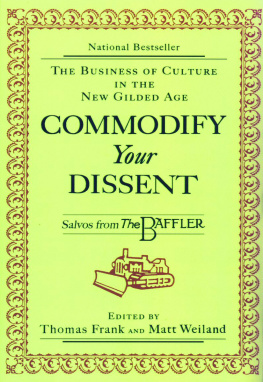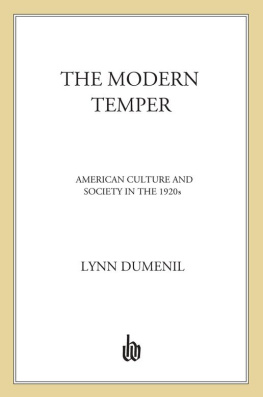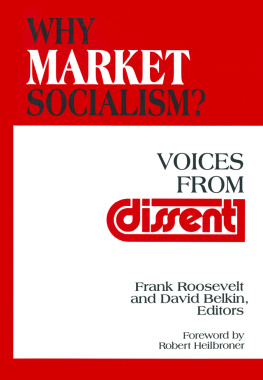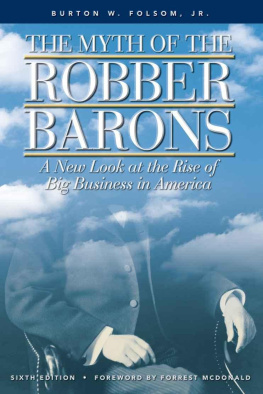Praise for Commodify Your Dissent
On bended knee, I beg you to get a copy of this book.
New York Observer
An insightful indictment of the new cultural order.
Chicago Tribune
Entertaining and enlightening. Since 1988, this Chicago-based journal has been a sharp observer of the maneuvers and machinations of the nations mass media. Indebted to Mencken and Chomsky, the surly young men and women of The Baffler have gone after contemporary consumer culture with a vengeance, ranting against false pieties and sloppy thinking.
Time Out New York
Combative and aggressively erudite.
Boston Phoenix
More than any other critics I can think of, the Bafflers have a finger on the pulse of our times. While others focus on the race to be hippest, or richest, or most subversive, Frank and co. correctly spend more time on a simpler question: Who owns the track.
Washington City Paper
Enjoyably cranky.
The Weekly Standard
Nowhere else will you find an intelligent critique of the culture of business and the business of culture thats laugh-out-loud funny.
In These Times
Compelling and funny. The journals satires are pitch-perfect.
Artforum
Throughout its run, The Baffler has been a consistently engrossing and frequently persuasive journal of cultural criticism. Commodify Your Dissent is funny, infuriating, fresh, dogmatic, startling, perceptive.
Rain Taxi
A snarky, rude and well-targeted analysis of the culture industry.
Mother Jones
Clear-eyed and pissed-off, The Baffler s writers rally around some suddenly-not-so-obsolete flagsH. L. Mencken, the Left, labor, punk rock. The essays are a relentless march against the economic-cultural order, assailing the confluence of business culture and 60s revolution rhetoric, the cynical marketing of Gen-X angst, the havoc wreaked on cities by Futurist dogma.
Spin
The Baffler s essayists have argued that the real story of the 1990s is not difference but sameness. Not diversity but consolidation, as wealth and power are concentrated in fewer and fewer hands and almost every aspect of life, from health care to publishing, bows to that ultimate heavy, the bottom line.
L. A. Weekly Literary Supplement
Indispensable.
Houston Chronicle
Commodify Your Dissent
Commodify Your Dissent
Salvos from The B AFFLER

Edited by
Thomas Frank and Matt Weiland

Copyright 1997 by The Baffler Literary Magazine, Inc.
Excerpt from The Big Money by John Dos Passos used by permission of Elizabeth H. Dos Passos. Excerpt from British Leftish Poetry, 193040 by Hugh MacDiarmid used by permission of Carcanet Press.
All rights reserved
The text of this book is composed in Fournier with the display set in Bodoni
Compositon by Com Com
Library of Congress Cataloging-in Publication Data
Commodify your dissent: salvos from The Baffler / edited by Thomas Frank and Matt Weiland.
p. cm.
Includes index.
ISBN: 978-0-393-31673-5
1. United StatesCivilization1970 2. ConsumersUnited States. 3. CorporationsSocial aspectsUnited States. 4. Popular cultureUnited StatesHistory20th century. 5. WealthSocial aspectsUnited States. I. Frank, Thomas (Thomas C.) II. Weiland, Matt. III. Baffler.
E169.04C648 1997
973.92dc21
97-34097
CIP
W. W. Norton & Company, Inc.
500 Fifth Avenue, New York, N.Y. 10110
www.wwnorton.com
W. W. Norton & Company Ltd.
Castle House, 75/76 Wells Street, London W1T 3QT
Contents
H.M.S. Baffler
O THER THAN The Baffler , I can think of no American journal of opinionleftist, new age, Ultra, post-modern, Jacobin, conservative, monarchist, evangelical, legitimist, neo-gothicthat could credibly describe its essays and criticisms as salvos. The less spirited journals produce muffled squibs and tentative ranging shots, sometimes sinister winks, loud coughs, or violent tremblings of the jowl, but not salvos, and never broadsides meant to sink anything larger than the pretensions of a disagreeable politician or the semiotic theory of a rival paraphrast.
Extend the sea-going metaphor to the armada of print that shows up every month on the newsstands or in the mail, and the different rigs and tonnages can be seen and classified as various kinds of ships. The business journals ( Forbes, Fortune, Business Week , etc.), like deep-laden oil tankers, heavy with the statistics that sustain the faith in late twentieth-century capitalism and fuel the lamps in the temples of Mammon; Vanity Fair and The New Yorker as festive as Caribbean cruise ships, glittering with strings of colored lights and loud with the music of trendy calypso bands (sometimes a celebrity falls overboard, which is a cause for great excitement and rejoicing); National Review and The New Republic towing long lines of barges loaded with intellectual waste products and the rusted hulks of political causes long since sold for scrap; the precious literary journals and reviews, too many of them to name or count, like Sunday yachts pirouetting through nimble turns, making a pretty show of running up and taking down their coded signal flags.
But H.M.S. Baffler I choose to imagine as a British frigate of thirty-six guns close-hauled on a port tack, temporarily detached from Vice Admiral Lord Nelsons Mediterranean squadron and operating without fleet orders in the Bay of Cant. Targets of convenience and opportunity present themselves at all points of the compassfat merchantmen sailing under the broad pennants of Cond Nast and Hearst, double-banked galleys rowed by gangs of captive intellectuals chained to the oars of the Cato Institute and the Chase Manhattan Bank, Chinese junks flying the Nike ensign, gilded barges bearing the magnificences of Martha Stewart and Arianna Huffmgton, high-speed cigarette boats running around in furious circles under the grinning command of George Gilder and Newt Gingrich.
The gunners aboard H.M.S. Baffler never miss, and the accuracy of their observation is a job to behold. The cannonade in the present volume falls most effectively on the flotilla that its several authors variously identify as The Culture Trust, The Body Demographic, The Age of Corporate Feudalism, The Mechanical Yammering of a consumer society long since departed from the rails of meaning or democracy. In brief and in sum, the advertised life formed in the firmament of Madison Avenues brand name strategies and then (after first being processed into a very large wheel of very pale cheese) sold to the American public in the different shapes and packagings marketed as movies, nose-rings, shoes, books, t-shirts, automobiles, music videos, after-shave lotions, alternative lifestyle, cyberspace, punk and post-rock, nihilist poets, and menacing hairdos. But it is all the same cheese, and its what we have here in the great American market space instead of art or thought or politics or literature.
The twenty-one essays in the book fire their grape-shot at different product linesThomas Frank talking about popular music, designated dissidents, and the New Age handbooks of corporate self-help, Keith White leafing through the merchandising catalogues disguised as magazines ( Details and Wired ); Maura Mahoney on pre-frabricated, beat generation angst (sold, like black cotton, in six yard lengths of hip-lit or la vie intellectuelle); Gary Groth on Quentin Tarantinos movies (the embodiment of living junk); Tom Vanderbilt on Edge Cities and the syntax (sometimes brutish, always cute) of commercial speech.


















